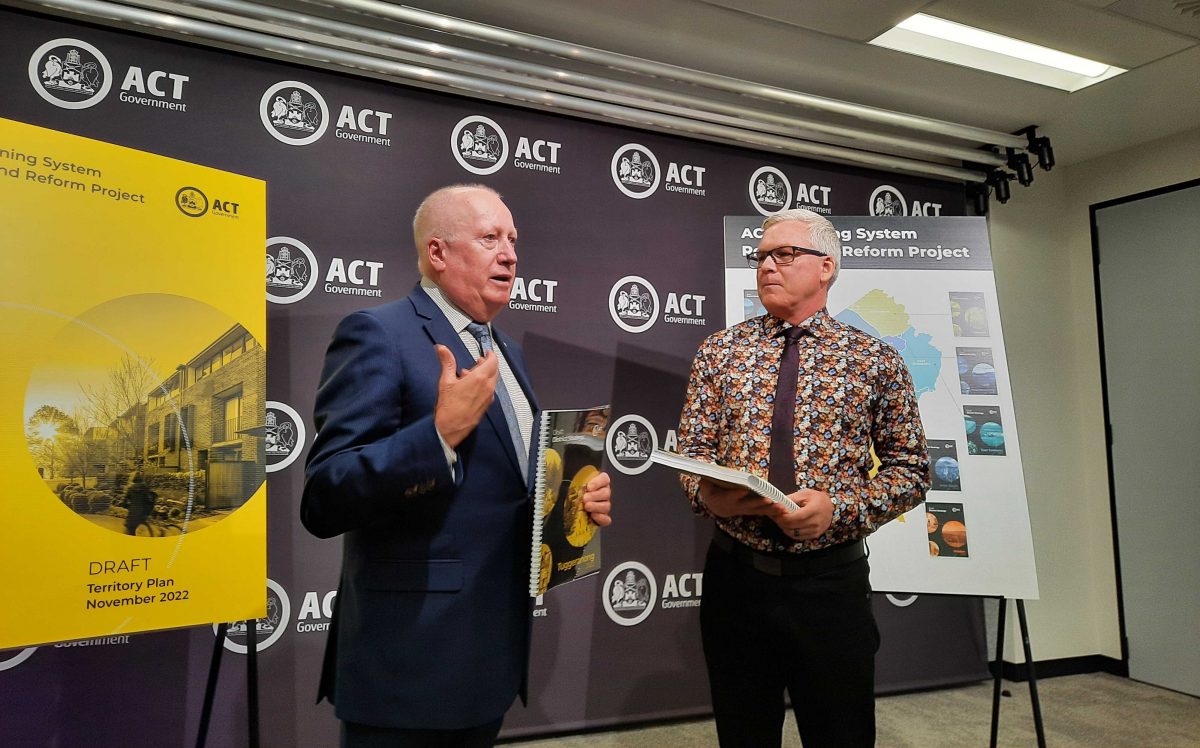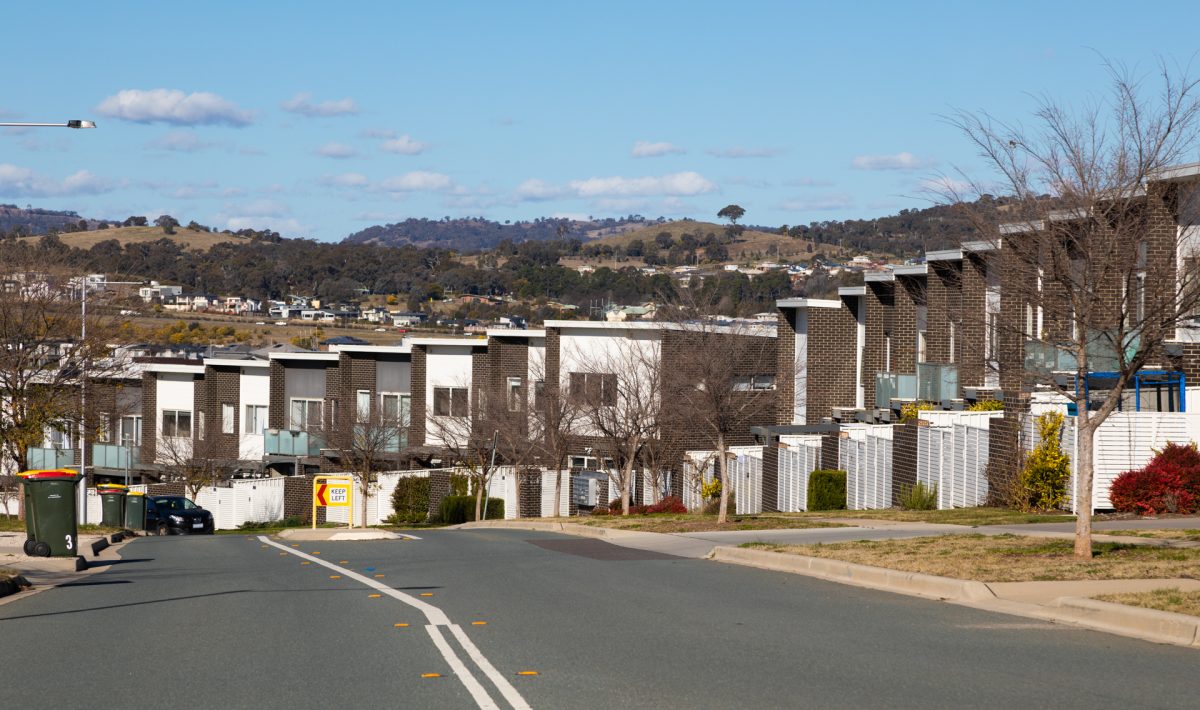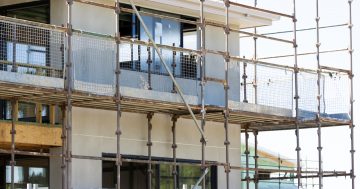
Planning Minister Mick Gentleman and Chief Planner Ben Ponton: a simpler system with better outcomes. Photo: Ian Bushnell.
The ACT Government has released drafts of a new Territory Plan and a series of District Planning Strategies for community consultation as part of its Planning System Review and Reform Project.
The proposed planning changes will pave the way for increased density across Canberra, including residential neighbourhoods, while attempting to balance environmental and amenity concerns.
It will mean the already well-advertised shift from a rules-based compliance system to one that is outcomes-based or relying on good design and proponents responding to the individual context of a site.
Underpinning this will be the nine District Strategies capturing their distinct characteristics, the new territory Plan, two design guides and technical specifications.
The Housing Design Guide will encompass such things as amenity, solar access and ventilation, while the Urban Design Guide is for larger developments and includes the public realm.
The hope is that the new, leaner system will result in higher quality housing and developments by providing more flexibility, reducing assessment delays by improving the quality of development applications, and speeding up the delivery of much-needed housing in the ACT.
At the same time, proponents will face a higher bar regarding the environment, green space and meeting climate change mitigation goals such as tree canopy and permeable space targets. However, the ACT Greens are pushing for stronger requirements to be built into the system.
Planning Minister Mick Gentleman said the proposed simpler system would make for better and more innovative development outcomes.
“It allows people to look at what they want to see on the ground rather than looking at the rules,” he said.
“So DAs, of course, will still need to be approved by the planning authority, but they’ll be looking at what you want to see for the future and not looking at the particular stack of rules that we have at the moment.
“Key stakeholders and the Canberra community have said to us they want something simpler, something easier to read, something easier to understand so they can prepare for the future.”

More density is coming to a suburb near you. Photo: Michelle Kroll.
Mr Gentleman said it would also help to build more housing, including community housing.
“I think decisions will be quicker, and of course, we do need to address our housing shortage and this will certainly assist that,” he said.
That includes more medium and high-density development in established suburbs, particularly along transport routes and local centres, and in general residential areas.
Proposed changes in the draft Territory Plan include adding community housing as a use to residential and community facility zones and alterations to dwelling density policies.
Developers will be able to subdivide blocks in RZ2 to RZ5 zones without having to construct the new dwellings first so ‘vacant’ blocks can be sold in areas close to services and facilities, the number of dwellings permitted in a multi-unit development in the RZ2 zone will be increased, as well removing development restrictions on block amalgamations and the maximum number of dwellings within a building.
But Mr Gentleman said the move to density should not mean the loss of open space and amenity.
“Young Canberrans have said to me they are happy to live in a denser city as long as it has really good urban open spaces,” he said.
Chief Planner Ben Ponton said the District Strategies would respect areas’ unique elements, but feedback showed many common values across Canberra.
He said planning treatment would vary across the districts, but they would still be subject to common rules.
“There are certain things that you’ll see, for example, a multi-unit development site in Tuggeranong or Gungahlin where the provisions in the Territory Plan will essentially be the same, but then there are other aspects in terms of the town centres where there are particularly unique elements and they’ll be treated differently,” he said.
New developments are also likely to require less parking to encourage active travel and public transport, but if you do have a park, it will come with electric vehicle charging points.
There is also a change to encourage more single-level residences for ageing in place by allowing RZ2 dwellings in multi-unit developments to be apartments.
Plot ratio will no longer be a mandatory requirement but a technical specification and will be set at 50 per cent for multi-unit developments in RZ1 and RZ2 zones.
Asked what developers, who will enjoy fewer restrictions but may face more demanding design requirements, were saying about the proposed new system, Mr Ponton chose his words carefully.
“They’re comfortable with the concept of an outcome-focused planning system,” he said.
But there is obviously more work to do.
Both Master Builders ACT and the Canberra Liberals criticised the time frame for the consultation, which closes on 14 February and takes in the Christmas-New Year shutdown.
CEO Michael Hopkins said there were 700 pages of Territory Plan, Technical Specifications and District Strategies to work through.
“While the new Territory Plan is an extremely important reform project, the amount of information required to be digested by the ACT community in a very short time period is an immense task,” he said.
“The ACT Government should support community and business stakeholders with whatever means necessary so that the highly technical Plan can be fully understood before it is finalised.”
Canberra Liberals Planning spokesperson Peter Cain said community organisations and industry had said the release schedule had made it difficult to get the full picture of the future of planning.
“Keeping the community and industry in the dark certainly makes the Labor-Greens Government’s job of introducing huge planning reform easier as they don’t have to address as much informed feedback,” Mr Cain said.
Mr Hopkins said a paradigm shift in planning rules, community attitudes and design and building quality was required if the ACT was going to deliver its share of the 200,000 houses the Federal Government wanted delivered every year.
“Canberra’s love affair with a car-dependant urban footprint dominated by single houses on quarter acre blocks must change if this vision is to be realised,” he said.
Mr Hopkins also said third-party appeals remained a threat to the goals of the planning system review.
“None of these ideals will be delivered as long as anyone can appeal to the ACT Civil & Administrative Tribunal for a few hundred dollars and hold up innovative development proposals for years,” he said.
The government will talk to the community councils, take submissions, and hold workshops and pop-up stalls across the consultation period.
To learn more, visit the YourSay website.





















